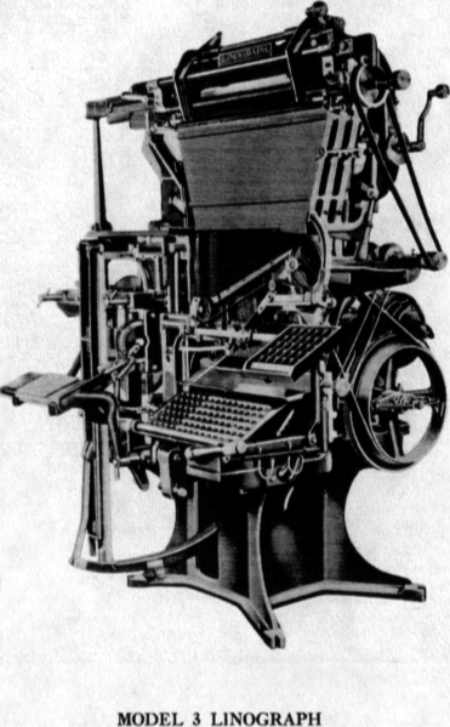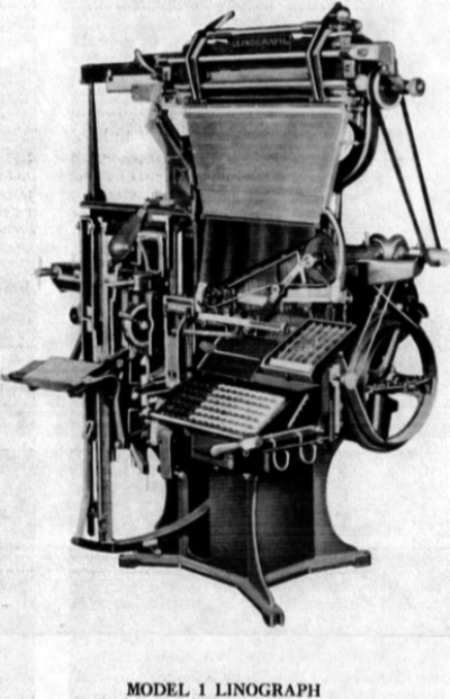
The basic patent on a combined assembling, casting and distributing machine granted to Ottmar Mergenthaler on 12 May 1882, expired in 1902 and the Mergenthaler patent on the Schuckers expandable wedge spaceband expired in 1909. Certain other Linotype patents became void soon after 1909.
By 1912 it was legally possible for anyone with sufficient capital to manufacture a machine that would assemble and cast lines of type.
Similar in design and operation to the Linotype, the Linograph is credited with being invented by Hans Pedersen who was born in Denmark in 1872, but emigrated to America at the age of 10 years with his parents.
They settled in Fergus Falls, Minnesota and immediately Hans Peterson (he changed the spelling of his name later) got a job at the local Norwegian newspaper, learning to set type by hand, eventually leaving school at age 12 to become a compositor.
“Tramp” Printer
He followed the trade and for some time was a “tramp” printer until he finally got a job on the Penny Press newspaper in Minneapolis. This company was one of the first in the Northwest to own linotype machines and Hans Petersen could see the potential and asked to learn how to run them.
He became a Linotype operator and in 1897 he started a Scandinavian trade composition plant. This is the period that Hans Petersen is credited with conceiving the ideas for a more simpler, efficient and more easily handled machine. After study, sketches and developing a working drawing, Hans Petersen decided to call his machine the Linograph.
A factory was established in Davenport, Iowa in July 1912 with the help of investors, and one year later in July 1913, the first Linograph was delivered to The democrat of Osceola, Iowa.
For a comparison of price at the time, a Linograph was selling for $1500, an Intertype for $2150, a Model 8 Linotype for $3500, a Model 9 Linotype cost $4000.
1920 – Over 700 Sold
The company developed from strength to strength and by 1920 it was worth about $2 million (then) and had produced more than 700 Linographs and had sold them not only in the US, but 21 other countries.
The Linograph was real competition for the Linotype and Intertype and in many printing offices it was the preferred machine favoured over the others.
Peder Ole Pedersen and Jens Christian Pedersen, brothers to Hans also worked to develop the company with almost pioneering vision of the vast potential not only in sales in Europe which they had conquered their share of, but the fertile fields of education in countries such as Russia and South America.
The Linograph was refined and improved over the years and in 1923 Hans Petersen built what was regarded as a truly remarkable machine, a machine with the unprecedented number of 12 magazines, each with 90 channels, casting faces from 5 to 24 point in wide matrices, and 30 to 60 point in condensed faces.
It could also use Linotype or Intertype matrices (standard Linograph matrices are/were a little shorter than Linotype and Intertype matrices).

Hans Petersen died in Davenport, Iowa on 25 December 1924. The company continued on with a Model 50 being exhibited at the 1938 meeting of the American Newspaper Association, and it created a sensation.
Perhaps if the fertile mind of Hans Petersen had not been lost to the Linograph Company in 1924, or if WWII with its constrictions of civilian manpower and vital materials had been averted, the Linograph machine would have been manufactured for several more decades.
An early Linograph machine, in working order but not having been operated for several years, is in the Museum of Transport and Technology, Auckland, New Zealand. It is a gas-pot heated model.
Acknowledgement: The material above (abridged by Terry Foster) from: Papers of the Linograph Corporation, Davenport, Iowa, Special Collections Department, University of Iowa Libraries, Iowa City, Iowa.
Linograph Preservation: There is a thread on the Metal Type Forum which gives details of a couple of projects to preserve these very rare linecasters. Take a look, and maybe join in, here: Dave Seat’s Linograph Project.
Hans Petersen is my Great Grandfather.
Dear Sharon
I am helping Vingaards Officin here in Denmark to find Danish relatives of Hans Petersen. Do you have contact with any of your relatives in Denmark?
Thanks in advance.
Yours Sincerely
Jørgen Nørgaard
Dear Sharon Potts
Vingaards Officin, Bogtrykmuseet Viborg is a great printing museum in Denmark.
I hope we can find an Linograph linecasting machine somewhere in the velt.
If You can you help us I will be wery happy?
Greathings
Ebbe Sørensen
Send an email to Denmark: Bogtrykmuseet.viborg@g.mail.com, and I will be very happy.
Ebbe Sorensen